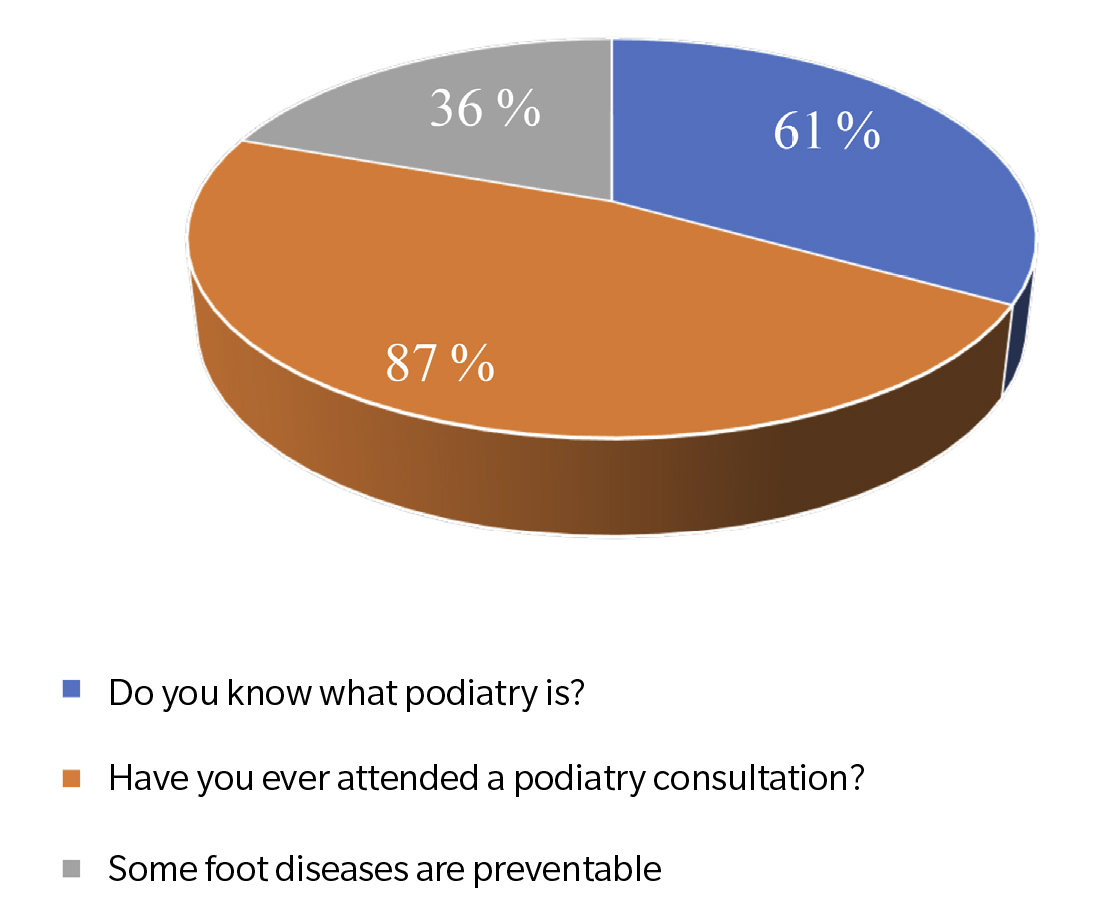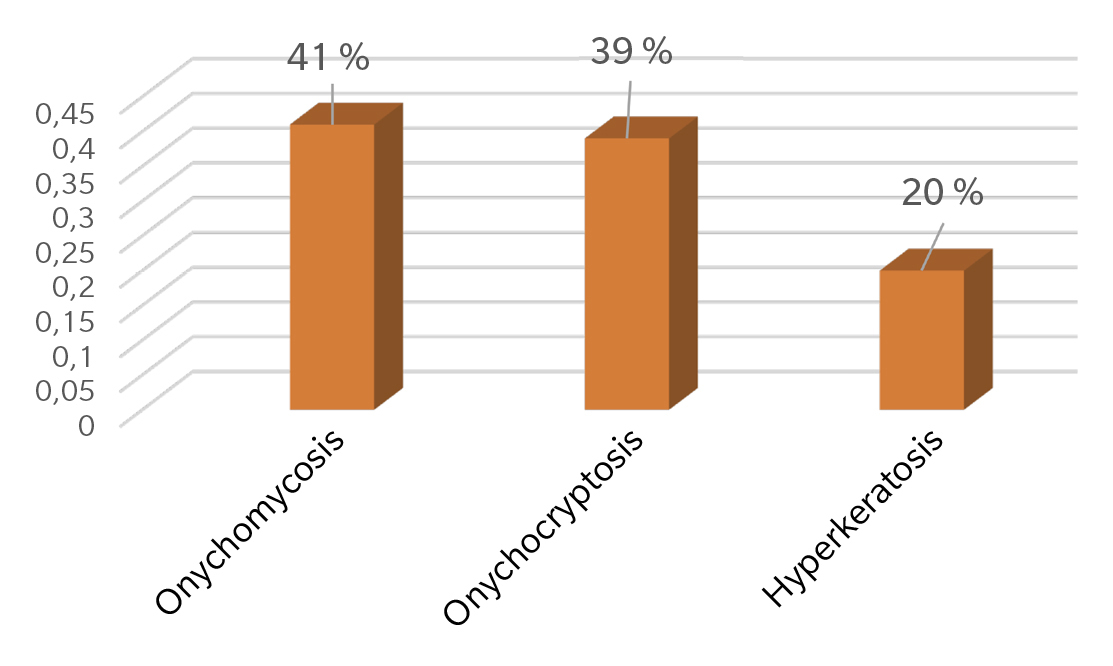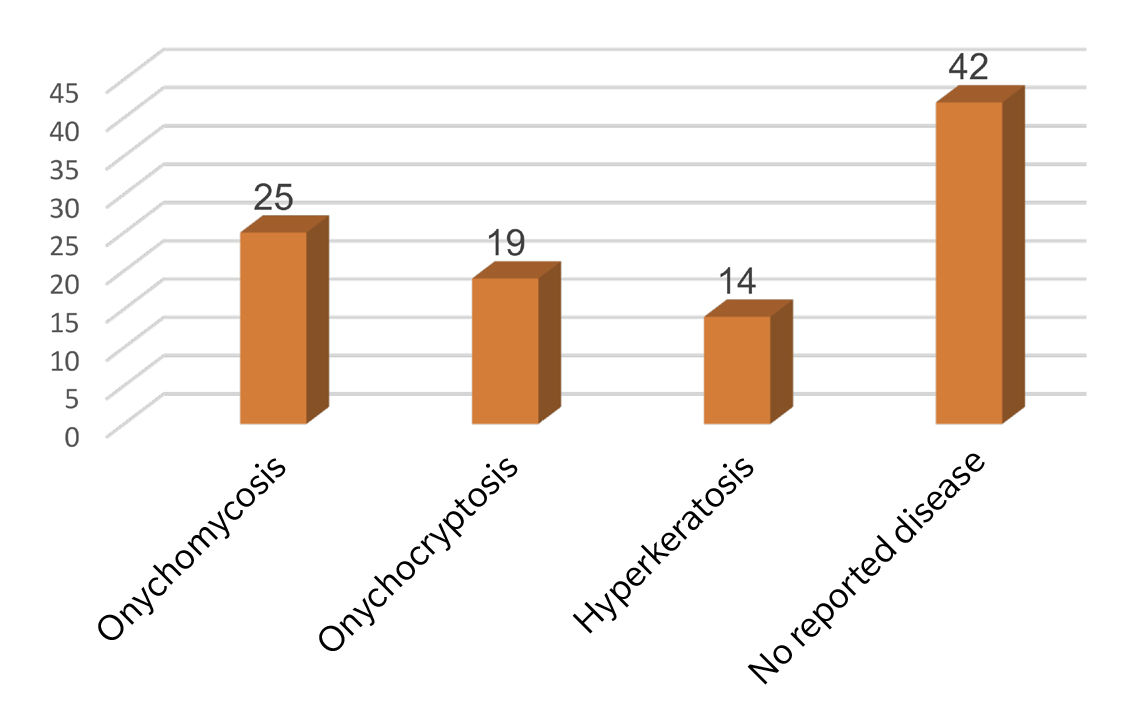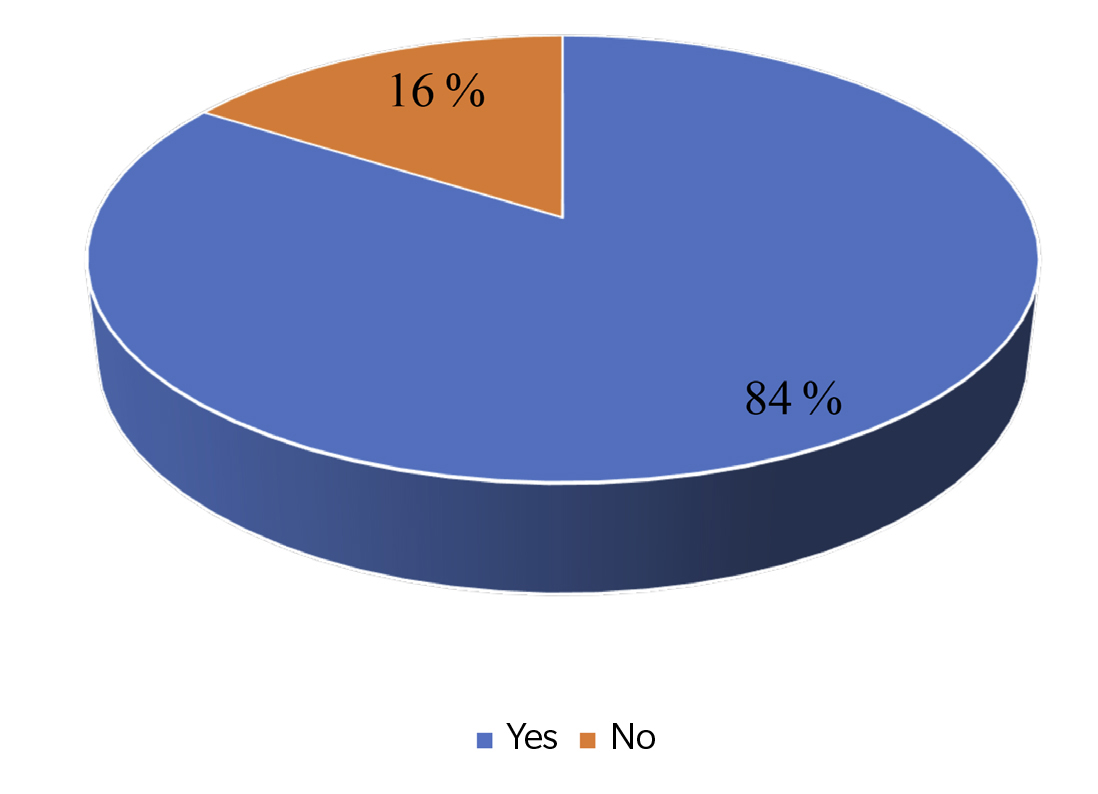10.20986/revesppod.2025.1722/2024
ORIGINAL
Knowlwedge about podiatry and the incidence of pathologies (onychomycosis, onychocryptosis and hyperkeratosis) in the population of Atarazana, Ecuador
Conocimiento sobre podología y la incidencia de patologías (onicomicosis, onicocriptosis e hiperqueratosis) en la población de Atarazana, Ecuador
Yiliam Fonseca Bodaño1
Frank Miranda Escobar1
Dámasa López Santa Cruz2
1Podología. ITB. Guayas, Guayaquil, Ecuador
2Medios Diagnósticos. Facultad de Ciencias Médicas Victoria de Girón. La Habana, Cuba
Abstract
Objectives: Podiatry is the medical specialty responsible for preventing, diagnosing and treating different diseases and disorders in the lower limbs, especially the feet. The aim of the present work was to evaluate knowledge about podiatry and the incidence of pathologies (onychomycosis, onychocryptosis and hyperkeratosis) in the population of Atarazana.
Patients and methods: A field sampling was carried out, using a quantitative approach to the population of young and older adults in the La Atarazana neighborhood located north of the city of Guayaquil, Ecuador, in August 2023. The sample under study was made up of 100 people living in the neighbourhood along the route from house to house. The podiatric conditions and pathologies studied: onychomycosis, hyperkeratosis and onychocryptosis. The data collected were obtained from information from questionnaires, validated by experts.
Results: From the survey carried out on 100 people from the population of Atarazana, the result was that more than 50% have suffered from some of the preventable pathologies.
Conclusion: It is evident that there is a limited level of knowledge in the population of Atarazana in relation to podiatry as a medical discipline. The majority of respondents demonstrated interest and willingness to receive podiatric care. The results indicate that the incidence of onychomycosis, onychocryptosis and hyperkeratosis in the population of Atarazana is significant. In particular, the high frequency of these pathologies underlines the importance of early detection, prevention and adequate treatment. They revealed that fear and lack of information are key barriers to seeking podiatric care in the community.
Keywords: Podiatry, population survey, onychomycosis, onychocryptosis, hyperkeratosis
Resumen
Objetivos: La podología es la especialidad médica encargada de prevenir, diagnosticar y dar tratamiento a distintas enfermedades y alteraciones en los miembros inferiores, en especial a los pies. El objetivo del presente trabajo fue evaluar el conocimiento sobre podología y la incidencia de patologías (onicomicosis, onicocriptosis e hiperqueratosis) en la población de Atarazana.
Pacientes y métodos: Se realizó un muestreo de campo mediante un enfoque cuantitativo de la población de adultos jóvenes y mayores; en el barrio La Atarazana, que se encuentra al norte de la ciudad de Guayaquil, Ecuador, en el mes de agosto del año 2023. La muestra objeto de estudio quedó constituida por 100 personas residentes del barrio por el recorrido de casa en casa. Las afecciones y patologías podológicas estudiadas fueron: onicomicosis, hiperqueratosis y onicocriptosis.
Resultados: A partir de la encuesta realizada a 100 personas de la población de Atarazana, se obtuvo como resultado que más del 50 % han padecido algunas de las patologías prevenibles.
Conclusión: Se evidencia que existe un nivel de conocimiento limitado en la población de Atarazana en relación con la podología como disciplina médica. La mayoría de los encuestados demostraron interés y disposición para recibir atención podológica. Los resultados indican que la incidencia de onicomicosis, onicocriptosis e hiperqueratosis en la población de Atarazana es significativa. En particular, la alta frecuencia de estas patologías subraya la importancia de la detección temprana, prevención y tratamiento adecuado. Revelaron que el miedo y la falta de información son obstáculos clave para buscar atención podológica en la comunidad.
Palabras clave: Podología, encuesta poblacional, onicomicosis, onicocriptosis, hiperqueratosis
Corresponding author
Dámasa López Santa Cruz
damasalopez@infomed.sld.cu
Received: 28-12-2024
Accepted: 22-04-2025
Introduction
Every part of the human body is important, and thus we must take care of it from head to toe. The lower limbs are the most neglected anatomical site by human beings, despite the fact that we use them to perform daily activities such as exercise, walking, dancing, working, and providing full support for our bodies. Foot health depends on the health of our legs and spine to maintain proper balance(1,2,3).
Podiatry is the medical specialty responsible for the prevention, diagnosis, and treatment of various diseases and disorders affecting the lower limbs, especially the feet. The professional who performs this function is called a podiatrist. Unfortunately, in Ecuador, this profession is not recognized due to various factors such as lack of information, misperceptions about this science, and ignorance of the conditions that affect this extremity—which in turn jeopardize people‘s well-being and can even endanger their lives(4,5).
There are many conditions widely treated in this area, the most frequently seen in podiatry consultations being onychomycosis, onychocryptosis, and hyperkeratosis. Onychomycosis is the most common nail disease and accounts for more than 50 % of nail disorders. It is caused by dermatophyte fungi, non-dermatophyte molds, or yeasts. It is an infection that continues to rise despite improvements in quality of life and personal hygiene(6). Most individuals affected by this disease acquire it through cross-infection, improper nail trimming, or trauma to the nails. Some seek treatment from untrained individuals or pedicurists, and often patients do not take appropriate precautions or visit a podiatrist for proper treatment.
In 2021, Díaz-Lima(7). stated that hyperkeratosis is a natural form of protection offered by the body and is defined as: hardening of the superficial layers of the skin, formed by accumulations of stratified corneal layers of the epidermis, as a reflexive protective mechanism in response to abnormal friction and pressure. The most recognized forms are grouped into six categories based on structural characteristics: non-nucleated hyperkeratosis, nucleated hyperkeratosis, complicated non-nucleated hyperkeratosis, complicated nucleated hyperkeratosis, keratodermas, and tumorous formations(7).
In such cases, it is necessary to consider the specific type of work performed by the patient and the type of footwear used in order to identify the causal factor that leads to abnormal friction and pressure, as well as the changes in pressure points. This is achieved through physical examinations conducted by the professional to provide appropriate treatment(8).
Another common condition encountered in podiatry clinics is onychocryptosis. Onychocryptosis is the penetration of a nail into any soft tissue zone of the nail complex (periungual groove or walls). It is one of the most common nail disorders in the foot, and recurrence may become chronic. It is of multifactorial origin. Onychocryptosis is a frequent reason for consultation in daily podiatry practice, accounting for approximately 20 % of foot-related patient visits.
For over 1,000 years, many different treatments have been proposed. Today, both conservative and surgical methods are available, and when performed with experience, they can cure the condition?. Let us remember that every profession arises from a need experienced by human beings, and podiatry is no exception. Therefore, the objective of this work is to evaluate knowledge of podiatry and the incidence of podiatric pathologies (onychomycosis, onychocryptosis, and hyperkeratosis) in the population of Atarazana.
Patients and methods
We conducted a field sampling with a quantitative approach among young and older adults aged between 30 and 80 years in the La Atarazana neighborhood, located in northern Guayaquil, Ecuador, during August 2023. Inclusion criteria for the study was young and older adults who were willing to participate nad resided in the La Atarazana neighborhood. Exclusion criteria was individuals under the age of 18 and non-residents of La Atarazana. The sample under study consisted of 100 residents of the neighborhood, identified through house-to-house visits, 60% of whom were women and 40%, men. The podiatric conditions and pathologies studied—onychomycosis, hyperkeratosis, and onychocryptosis—were diagnosed by a specialist (podiatrist). Data were collected using questionnaires validated by experts. Absolute frequencies and percentages were used as summary measures for quantitative variables.
The questionnaire included the following five questions:
- Do you know what podiatry is?
- Have you ever attended a podiatry consultation?
- Did you know that the pathologies affecting the lower limbs, specifically the feet, can be prevented?
- Are you familiar with any of these pathologies?
- Do you believe you suffer from any of these conditions?
Results were presented using tables and statistical charts. Data were reviewed, analyzed, stored, and organized by the primary project team members using Microsoft Excel and Word.
Results
Following diagnosis by a specialist (podiatrist), a total of 100 individuals were surveyed. When asked, “Do you know what podiatry is?” 39 % of respondents demonstrated knowledge of this medical field focused on foot care, while the remaining 61% admitted to lacking any understanding of the discipline.
In response to the question, “Have you ever attended a podiatry consultation?” 13% of respondents indicated that they had experience with a podiatrist. On the other hand, 87% said they had never been to such a consultation—likely due to a general lack of awareness about the field of podiatry.
When asked the third question—”Did you know that conditions affecting the lower limbs, especially the feet, can be prevented?”—64% of respondents affirmed that they were aware of the importance of prevention, diagnosis, and treatment, whereas 36% admitted they were unaware of the range of care a podiatrist can provide (Figure 1).

Figure 1. Percentage knowledge about podiatry and foot diseases that can be prevented in the locality of Atarazana.
Regarding knowledge of specific preventable conditions, onychomycosis had the highest awareness at 41%, representing 85 people. Onychocryptosis followed closely at 39% (80 people), and hyperkeratosis was the least known, at 20% (40 people) (Figure 2).

Figure 2. Percentage of knowledge about certain foot pathologies among people in the locality of Atarazana, diagnosed by a specialist.
When asked whether they suffered from any of these foot conditions and to specify which, it was observed that more than 50 % of Atarazana residents had experienced some pathology affecting the lower limbs. Among these, onychomycosis was the most common, affecting 25 individuals. At the same time, 19 individuals reported suffering from onychocryptosis, and 14 reported hyperkeratosis. The remaining 42 individuals stated they did not suffer from any of these conditions (Figure 3).

Figure 3. Total number of people who reported suffering from any of the mentioned pathologies in the locality of Atarazana.
Finally, when asked whether they would be willing to attend podiatry consultations after being informed of their importance, 84% of the 100 respondents expressed a willingness to do so for the purposes of prevention, diagnosis, and treatment. However, around 16% of the residents indicated they would not pursue such consultations, due to fear stemming from the community’s general lack of information about this area of healthcare (Figure 4).

Figure 4. Total percentage recognizing the importance of attending podiatry consultations in the locality of Atarazana.
Discussion
Inequality and discrimination are elements that significantly impact the challenges addressed by the 2030 Agenda and inclusive social development. For this reason, the themes and actions proposed in the Regional Agenda for Inclusive Social Development (ARDSI)—approved by member countries of the Regional Conference on Social Development in October 2019—must consider the diverse situations of exclusion present in the region(10).
One branch of medicine is podiatry, which is dedicated to the diagnosis and treatment of pathologies and disorders affecting the lower limbs. It plays a crucial role in ensuring foot health and offers patients solutions to maintain a healthy lifestyle.
Onychomycosis is a condition that can occur at any age, though it is more frequently observed in older adults. It affects approximately 50% of individuals over the age of 70. It is rarely seen in children, but those with Down syndrome or immunodeficiencies are at higher risk6. In the present study conducted on a sample of 100 individuals with an average age of 60 years—60 % female and 40 % male—41 % were diagnosed with onychomycosis, a common fungal nail infection affecting both the upper and lower limbs.
The findings align with those of Martínez(11). et al. (2021), who asserted that onychomycosis is a common fungal infection in the nails of older adults. Contributing factors include increased incidence of age-related immunodeficiencies, use of closed or damp footwear (or both), walking barefoot in public bathrooms, and frequent trauma—all of which increase the prevalence rate(11).
We can observe that 61 % of Atarazana residents stated they had never attended a podiatry consultation, highlighting a lack of culture around visiting podiatrists for foot care—despite this being a way to prevent diseases that can potentially lead to amputation.
Sánchez, in 2024, in the article The Importance of Podiatry in Primary Care, states that the feet are an essential part of human anatomy, and their health directly impacts people’s quality of life. Podiatrists are experts in foot care and play a vital role in the prevention and treatment of conditions that can severely affect foot health. Moreover, their work can contribute to long-term cost reduction in the health care system(4).
One of the most frequently observed conditions in primary care is onychocryptosis, and its treatment is effective in the early stages of the disease, thereby preventing complications or recurrence of nail embedding. Delayed treatment can prolong the inflammatory process and lead to discomfort that limits the patient’s quality of life. In primary care, surgical procedures for onychocryptosis are typically performed on an outpatient basis, allowing for rapid and safe reintegration of the patient into daily activities and regular work routines. Equally important is proper patient education on hygienic habits, the use of comfortable footwear, and correct nail trimming techniques.
Callejo(13). (2021) states that “it is a multifactorial condition, but the triggering factor is usually improper nail trimming, such as cutting the edges too short and rounding them. Additionally, other contributing factors include foot morphology (e.g., bunion-prone feet), obesity, excessive sweating, wearing high and narrow shoes, and the use of certain medications (such as oral retinoids)” (12).
Hyperkeratosis is a common condition affecting individuals and is essentially an area of hardened skin on the feet. It is important to treat it podiatrically to prevent complications and maintain overall health, as its presence may indicate underlying health issues. Aldea Manrique et al. 13 (2020), in an article on palmoplantar hyperkeratosis, recommend investigating for dermatophyte infections in cases of hyperkeratotic lesions on the hands or feet, as this diagnosis is often overlooked, and appropriate treatment can yield excellent results(13).
Hidalgo Muriel(14). (2021) posits that hyperkeratosis generally arises from continuous pressure or friction, which displaces the superficial layers of the skin. It is a defense mechanism triggered by repeated rubbing, such as when tight footwear presses against the feet, leading to the formation of calluses(14).
We can affirm that there is political will from the government to ensure health care access at the primary level for all individuals. However, awareness of podiatry as a specialty has yet to be achieved among people in rural provinces due to limited promotion, lack of knowledge, and both economic and geographic barriers to accessing podiatric services. For this reason, the authors strategically carried out outreach campaigns to serve these populations.
In conclusion, this article demonstrates that the population of Atarazana has a limited level of knowledge regarding podiatry as a medical discipline. Although most respondents showed interest and willingness to receive podiatric care, many lacked basic information about the functions and benefits of this specialty. This highlights the need for educational campaigns to raise awareness about the importance of podiatric care and its implications for overall health. The results indicate a significant incidence of onychomycosis, onychocryptosis, and hyperkeratosis in the Atarazana population. The high frequency of these conditions underscores the importance of early detection, prevention, and appropriate treatment. While these conditions are not life-threatening, they can cause considerable discomfort and affect patients’ quality of life. Thus, it is essential to enhance access to podiatric services within the community. Interviews and focus groups revealed that fear and lack of information are key barriers to seeking podiatric care. Nevertheless, the high percentage of participants willing to receive treatment reflects an opportunity to implement educational and awareness programs. As such, campaigns were carried out to serve these vulnerable groups.
Authors’ contributions
Conceptualization and design: YFB, FME.
Data collection: YFB, FME.
Drafting and writing: YFB, DLSC.
Final revision: DLSC.
Conflicts of interest
None declared.
Funding
None declared.
References
- González Cedeño M, Alfonseca Guerra M, Hernández Rodríguez M. Enfoque social del manejo de pie diabético desde la atención primaria de salud. Rev Hum Med. 2022;22(2):421-38.
- Abreus-Mora J, González-Curbelo V, del-Sol-Santiago F, Mena-Pérez O, Abreus-Vázquez J, Bernal-Valladares. E. Efecto de programa de ejercicios físicos para la fuerza de extremidades inferiores en adultos mayores. Revista Finlay. 2022;12(1).
- Peñafiel-Labanda F, Guilcamaigua-Toapanta D, Rodríguez-Vargas A. Ejercicios físicos terapéuticos para la inclusión de estudiantes con dismetría de miembros inferiores a la clase de Educación Física. 593 Digital Publisher CEIT. 2024;9(3):1125-38. DOI: 10.33386/593dp.2024.3.244.7
- Sánchez Hernández S. La importancia de la podología en la atención primaria. Aten Primaria. 2024;56(2):102811. DOI: 10.1016/j.aprim.2023.102811.
- Rivera García CG, Espinosa Manfugás JM, Valdés Bencomo YD. La investigación científica en las universidades ecuatorianas. Prioridad del sistema educativo vigente. Rev Cuban Educ Sup. 2017;36(2):113-25.
- Almirallmed. Cuidado de las uñas. Todo sobre… la onicomicosis. 2023 [citado 14 Nov 2024]; Monografía. Disponible en: http://podologia.almirallmed.es/monografias/onicomicosis/
- Díaz-Lima M, Fernández-Valle O, Amigo-Castañeda P, Domínguez-Llama JL, Hernández-Suárez Bárbaro A. Hiperqueratosis plantar. Rev Med Electron. 2021;43(6):1728-37.
- Oblitas Guerrero AE, Oblitas Guerrero SM. Prevención y educación en pie diabético. Rev Cuban Med. 2023;62(4). DOI: 10.26495/curae.v6i1.2364.
- Márquez Reina S, Lafuente Sotillos G, Domínguez Maldonado G. Estudios conservadores de la onicocriptosis. Revisión bibliográfica narrativa. Rev Esp Podol. 2018;29(1):34-42.
- Villar García M-G, González Calderón DE. Representar la vulnerabilidad. Una reflexión desde el diseño de la comunicación. Cuadernos. 2023;(205). DOI: 10.18682/cdc.vi205.9786.
- Martínez Rodríguez B, Lima León CE, Vera Pérez Y, Medinas Artiles A, Ferrer García M, León Granado Julio C. Afecciones podológicas en adultos mayores atendidos en la Consulta de Podología general. Acta Méd centro. 2021;15(2):297-308.
- Callejo Mora A. Uñas encarnadas (onicocriptosis). 2021. Disponible en: https://cuidateplus.marca.com/enfermedades-del-pie/unas-encarnadas.html
- Aldea Manrique B, Sánchez Bernal J, Lezcano Biosca V. Hiperqueratosis palmoplantar de larga evolución. SEMERGEN. 2020;46(2):6-7. DOI: 10.1016/j.semerg.2019.10.005.
- Hidalgo Muriel M. Hiperqueratosis palmoplantar: cómo tratar las durezas de los pies. TopDoctors. 2021. Disponible en: https://www.topdoctors.es/articulos-medicos/hiprqueratosis-palmoplantar-como-tratar-las-durezas-de-los-pies